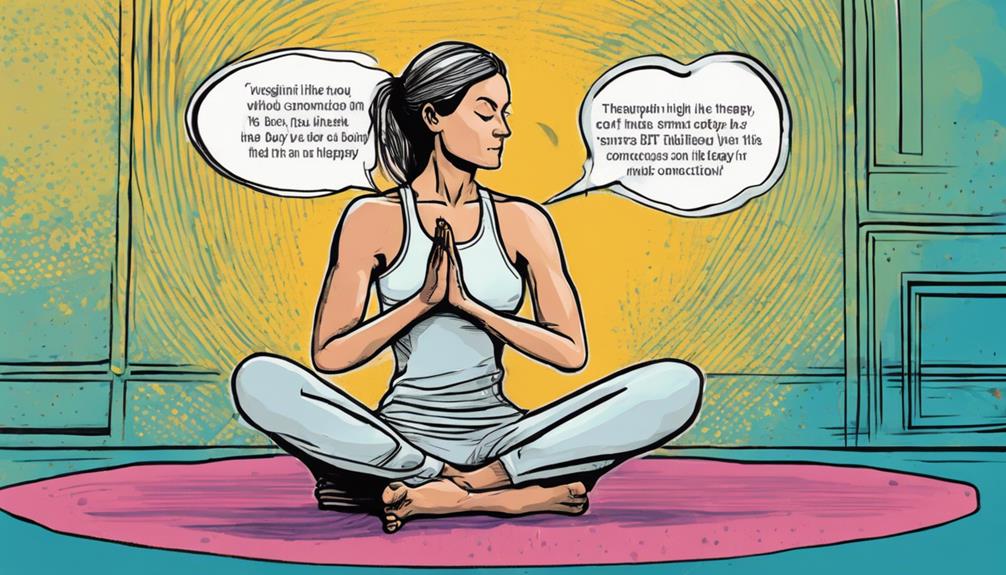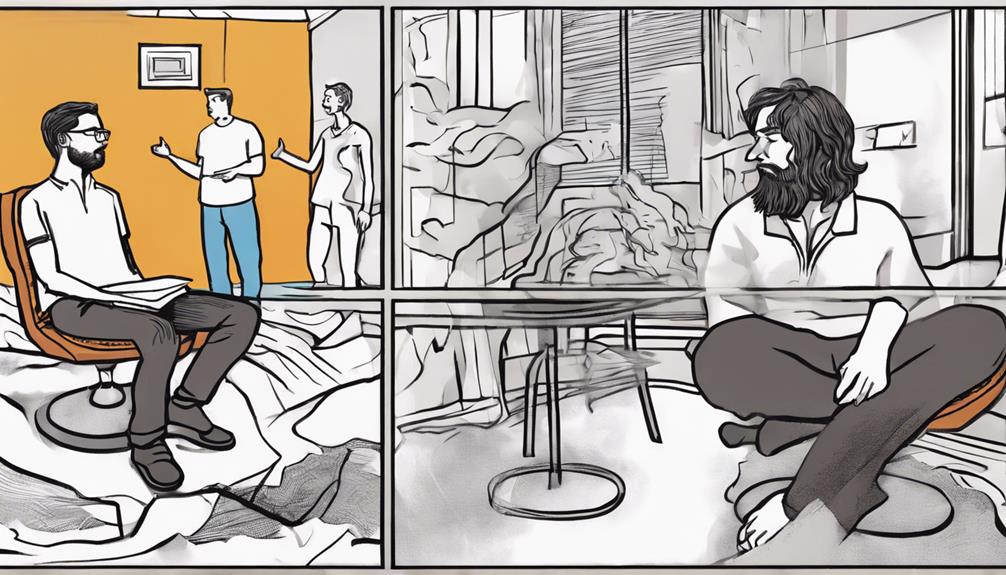Somatic Therapy
Does Somatic Therapy Make You Tired? Side Effects Explained!
Overcoming fatigue from somatic therapy? Discover why it can leave you tired and how it's a sign of healing progress.

Undergoing somatic therapy might leave you feeling drained as it facilitates the release of tension and emotions from your physical and mental being. The act of releasing these feelings can bring about fatigue after a session as it involves intensive work to identify and tackle deep-seated issues. Additionally, you might experience sensory exhaustion due to an increased level of awareness throughout the therapy. However, experiencing fatigue is often a natural aspect of the healing journey, signaling that progress is being made. It is crucial to remember that taking time for self-care and rest after your sessions is vital for managing this tiredness and enhancing the effectiveness of somatic therapy.
Key Takeaways
- Fatigue can occur due to emotional release and heightened body awareness.
- Increased relaxation may lead to post-session tiredness.
- Emotional processing during therapy can cause temporary fatigue.
- Sensory fatigue might occur from intense focus and heightened awareness.
- Rest, integration, and self-care are essential for managing therapy-induced tiredness.
Physical Reactions in Somatic Therapy
During somatic therapy, you may experience physical reactions that include fatigue as your body releases tension and emotions. These physical reactions are a result of your body's physiological responses to the therapy.
As your body adjusts to new movement patterns and releases stored stress, it's common to feel tired after sessions. The fatigue you may feel is a sign that your body is processing and integrating the changes brought about by somatic therapy.
Increased relaxation and improved body awareness during the sessions can also contribute to feelings of tiredness. Embracing these physical reactions as part of the healing process can help you understand the deep work your body is undergoing.
Remember that fatigue after somatic therapy is a natural response as your body works towards releasing tension and promoting overall well-being.
Emotional Release and Tiredness

As emotional release occurs in somatic therapy, it's common to experience feelings of tiredness as your body processes and releases stored emotions. When emotional tension is released during somatic therapy sessions, it can lead to temporary fatigue as your body adjusts to the changes.
Feeling tired after somatic therapy is a typical side effect as your body undergoes shifts in energy and emotional processing. The process of releasing emotional and physical tension in somatic therapy can be draining, resulting in post-session tiredness.
It is essential to listen to your body and allow yourself to rest after somatic therapy sessions to help manage the tiredness associated with emotional release. By giving your body the time it needs to recover, you can better regulate the effects of emotional release and reduce the impact of temporary fatigue.
Sensory Awareness Impact

You might find that focusing on sensory awareness during somatic therapy can bring about heightened bodily sensations and a deeper understanding of your internal processes.
This increased attention to your body's signals could potentially be exhausting, both mentally and physically.
Learning to manage potential sensory overload and balancing your body's responses may be crucial aspects to keep in mind during your somatic therapy sessions.
Sensory Fatigue Possibility
Experiencing sensory fatigue in somatic therapy sessions can result from heightened awareness of bodily sensations and intense focus on them. When you become highly attuned to your bodily experiences during therapy, feeling mentally exhausted from the increased sensory awareness is possible.
This heightened sensitivity may lead to feeling overwhelmed or drained, showing itself as tiredness or emotional fatigue. The side effects of sensory fatigue in somatic therapy can leave you feeling mentally fatigued or emotionally drained.
To manage sensory fatigue during somatic therapy, taking breaks when necessary is crucial. These pauses allow you to reset and prevent excessive drain from the intense focus on bodily sensations.
Engaging in self-care practices can also help alleviate sensory fatigue. Sharing your experiences with your therapist can provide insights and strategies to navigate heightened sensory awareness effectively.
Body Awareness Effects
Increased body awareness in somatic therapy enhances your sensory perception and deepens your connection to internal sensations. This heightened sensory awareness can lead to a more profound understanding of your body's signals and a deeper engagement with your inner experiences.
As you explore into this journey of self-discovery and healing, here are some effects of body awareness in somatic therapy:
- Heightened sensory perception: You may notice subtle sensations and cues from your body that were previously overlooked.
- Internal sensations exploration: Exploring internal experiences can bring up buried emotions and memories.
- Sensory feedback integration: The mind works to process and make sense of the increased sensory input, which can be mentally taxing.
- Emotional releases: Connecting with internal sensations may lead to the release of pent-up emotions and energy.
- Physical tension release: Increased body awareness can help identify and release physical tension stored in the body, promoting relaxation and healing.
Sensation Overload Management
Managing sensory overload in somatic therapy involves implementing techniques to regulate internal sensations and prevent exhaustion. When sensory overload occurs, it can result in feelings of tiredness and fatigue due to heightened awareness of internal stimuli.
To prevent overwhelming tiredness, it's vital to pace yourself during somatic exercises, adjusting the intensity and duration as needed. Sensory awareness impact varies among individuals; while some may feel fatigued, others might experience increased energy levels.
Practicing grounding techniques, like focusing on the present moment or connecting with the environment, can help manage sensory overload. Additionally, titration – breaking down exercises into smaller, more manageable parts – can prevent exhaustion and maintain energy levels during therapy sessions.
Communication is key in somatic therapy; if you notice sensations of tiredness or fatigue, it's important to express this to your therapist. By communicating your experiences, adjustments can be made to ensure a more balanced and beneficial somatic therapy session.
Initial Reactions in Therapy

You may initially feel some fatigue or tiredness during somatic therapy sessions as your body begins to release pent-up tension and emotions. This reaction is a natural part of the therapeutic process, indicating that your body is actively responding to the somatic therapy techniques.
Here are some key points to understand about the initial reactions in therapy:
- The release of stored trauma or stress might lead to temporary feelings of exhaustion or heaviness.
- Fatigue in somatic therapy shows that your body is working through deep-seated issues and emotional blockages.
- Feeling tired during or after sessions is common as your body adjusts to the therapeutic process.
- It's typical to experience fatigue as your body starts the healing process and restores balance.
- Fatigue serves as a signal that your body is engaging with the therapy and releasing held tension and emotions.
Therapy Benefits and Credentials

Sarah Warren, a Certified Clinical Somatic Educator, brings expertise in addressing chronic pain and enhancing physical well-being through somatic therapy. Her credentials and experience play a crucial role in the effectiveness of Clinical Somatics for addressing physical discomfort and promoting overall wellness. The Pain Relief Secret book authored by Sarah Warren provides valuable insights into achieving a pain-free life through somatic education and practice.
To better understand the benefits of somatic therapy and Sarah Warren's credentials, let's take a look at the table below:
| Benefits of Somatic Therapy | Credentials of Sarah Warren |
|---|---|
| Alleviates back, neck, shoulder, hip, and knee pain | Certified Clinical Somatic Educator |
| Improves conditions like scoliosis | Author of Pain Relief Secret book |
| Enhances physical well-being | Specializes in addressing chronic pain |
Sarah Warren's dedication to somatic therapy and her in-depth knowledge make her a trusted professional in the field, offering individuals a path towards a healthier and pain-free life.
Understanding Somatic Therapy Effects

Experiencing fatigue post-somatic therapy sessions can be a common side effect due to the release of stored tension and emotions from the body. This process of addressing deep-rooted emotions and traumatic experiences can lead to physical symptoms and emotional exhaustion.
Here are some key points to help you understand the effects of somatic therapy:
- Release: Somatic therapy involves releasing stored tension and emotions from the body.
- Integration: Allowing time for the integration of the work done during therapy sessions is necessary.
- Rest: Listening to your body and taking rest when needed is vital for the healing process.
- Feelings: The process may bring up intense feelings that can contribute to feelings of fatigue.
- Temporary: Fatigue post-therapy sessions is often temporary as the body adjusts to the release of stress and tension.
While feeling tired is a common experience, many individuals also report a sense of relaxation and lightness after somatic therapy sessions.
Getting Started With Therapy

Before you embark on somatic therapy, make sure to establish clear emotional and physical goals for your sessions. Building trust and a good rapport with your therapist is essential for a positive experience.
Remember to take into account potential therapy fatigue and ways to manage exhaustion as you commence your therapeutic journey.
Initial Therapy Fatigue
When beginning somatic therapy, it's common to experience initial therapy fatigue as your body adapts to processing emotions and releasing tension. This tiredness is a natural part of the therapy process as your body reacts to the emotional release and heightened awareness during sessions.
Here are some key points to keep in mind:
- Feeling tired after starting somatic therapy is normal and can indicate your body's response to releasing stored stress and trauma.
- Therapy fatigue may be a sign that your body needs rest and time to integrate the changes occurring during therapy.
- Fatigue in somatic therapy can be a signal for your therapist to adjust the session pace or techniques to better support your needs.
- It's crucial to communicate any fatigue or tiredness with your somatic therapist to make sure you receive the necessary support and modifications in the therapy process.
- Remember that initial therapy fatigue is a common part of the somatic therapy journey, and with open communication, you and your therapist can navigate it effectively.
Managing Therapy Exhaustion
Begin by incorporating self-care practices to manage therapy exhaustion when initiating your somatic therapy journey.
Engaging in self-care activities such as meditation, gentle exercise, or spending time in nature can help replenish your energy levels. Adequate rest is vital in supporting your body through the healing process.
Communicating openly with your somatic therapist about any feelings of tiredness or fatigue can aid in adjusting the pace of your sessions to better suit your needs. Remember to listen to your body's signals; if you feel overwhelmed, don't hesitate to take breaks during therapy sessions.
Pacing yourself is key to preventing therapy exhaustion from becoming debilitating. It's important to recognize that while therapy exhaustion is a normal part of the healing process in somatic therapy, it shouldn't persist in a way that hinders your daily functioning.
Frequently Asked Questions
Can Somatic Exercises Make You Tired?
Somatic exercises can make you tired as your body adjusts to new movement patterns and releases stored stress. Feeling tired after somatic therapy is a common reaction, signaling that your body is responding to changes and processing releases.
What Are the Negative Effects of Somatic Therapy?
Somatic therapy might just leave you feeling more alive – beware of that energy boost! But seriously, possible temporary fatigue is a common side effect due to emotional and physical release. Keep open communication with your therapist.
How Do You Feel After Somatic Experiencing?
After somatic experiencing, you might feel physically and emotionally drained. This exhaustion stems from releasing stored tension and emotions. Your body processes the released energy, leading to fatigue. Rest and self-care are essential for recovery and integration.
What Is Somatic Trauma Release?
Somatic trauma release involves techniques like gentle movements, breath work, and body awareness to release stored physical and emotional trauma. It aims to address symptoms of trauma, PTSD, and chronic stress through somatic experiencing and body-centered therapies.
Conclusion
So, does somatic therapy make you tired?
The truth is, yes, it can. But it's not necessarily a negative side effect.
In fact, feeling tired after somatic therapy sessions can be a sign that your body is releasing stored tension and emotions, leading to a deep sense of relaxation and healing.
So don't be afraid of feeling tired – it's all part of the process towards better emotional and physical well-being.
Somatic Therapy
Is DBT Somatic Therapy? Find Out Here!
Intrigued to learn if DBT is somatic therapy? Uncover its holistic approach to mental health and the integration of somatic elements.

DBT does not classify as somatic therapy, but it does embrace somatic components to support a comprehensive mental health strategy. This approach melds behavioral with humanistic methods, highlighting the mind-body connection. Although DBT is not strictly somatic, it recognizes the importance of physical activities such as yoga and meditation in promoting general health. To grasp more about DBT’s incorporation of somatic elements, explore its principles and methods for a complete insight into its holistic approach towards mental health.
Key Takeaways
- DBT is not solely somatic therapy.
- DBT integrates behavioral and humanistic interventions.
- Somatic therapy emphasizes the mind-body connection.
- DBT focuses on mindfulness skills and emotional regulation.
- While related, DBT and somatic therapy have distinct approaches.
DBT Origins and Development
DBT Somatic Therapy originated and was developed by Marsha Linehan in the late 1970s. Marsha Linehan, a psychologist, created DBT initially for highly suicidal individuals. The therapy combines behavioral and humanistic interventions, aiming to find a balance between fostering change and promoting acceptance.
One of the central aspects of DBT is the integration of mindfulness skills. These skills encourage individuals to hold apparent contradictions simultaneously, helping them navigate complex emotional experiences effectively. Through DBT, individuals aim to cultivate what's known as a Wise Mind, where emotional experiences and rationality are merged for optimal mental health outcomes.
Marsha Linehan's pioneering work in developing DBT has transformed the field of psychology, offering a unique and effective approach to addressing self-harming behaviors and promoting overall well-being.
Core Principles of DBT

Let's now explore the core principles of DBT.
DBT emphasizes the importance of finding a balance between change and acceptance while incorporating mindfulness skills.
It also highlights the significance of holding contradictions and validating others' experiences to promote healing and growth.
Understanding these principles is crucial for integrating DBT effectively into somatic therapy practices.
DBT and Somatic Therapy
When exploring the core principles of DBT and somatic therapy, it becomes evident that their combined focus on the mind-body connection offers a holistic approach to mental health treatment. DBT, known as Dialectical Behavioral Therapy, integrates behavioral and humanistic interventions to address mental health issues. On the other hand, somatic therapy emphasizes the interconnectedness of thoughts, emotions, and sensations, aiming for holistic healing. Both approaches incorporate physical and psychological techniques to help individuals achieve mental wellness.
In DBT, finding a balance between change and acceptance is key, while somatic therapy focuses on addressing mental health through a comprehensive lens. DBT places a strong emphasis on mindfulness skills, teaching individuals to be present and aware of their thoughts and emotions.
In contrast, somatic therapy may involve physical practices like yoga, meditation, and bodywork to help individuals connect with their bodies and alleviate psychological distress. Together, DBT and somatic therapy offer a holistic approach that integrates both mental and physical well-being.
Key Differences Explained
Understanding the core principles of Dialectical Behavioral Therapy (DBT) involves recognizing key differences that set it apart in mental health treatment approaches. DBT emphasizes a delicate balance between acceptance and change when addressing various mental health conditions.
It incorporates mindfulness skills as a fundamental practice to promote self-awareness and emotional regulation. One of the unique aspects of DBT is its focus on cultivating a Wise Mind, which combines emotional experience with rationality to make balanced decisions. This therapy encourages individuals to hold apparent contradictions simultaneously, fostering understanding and personal growth.
Unlike traditional therapeutic approaches, DBT doesn't view acceptance and change as opposing forces but rather as complementary elements in the healing process. Initially developed for highly suicidal individuals, DBT has gained widespread acceptance for treating a range of mental health conditions by integrating the principles of acceptance and change with self-awareness and emotional regulation.
Integrating Healing Practices
Incorporating healing practices into Dialectical Behavioral Therapy (DBT) involves integrating cognitive, emotional, and behavioral techniques to promote holistic well-being. DBT emphasizes the mind-body connection by focusing on holistic healing, which includes distress tolerance, emotional regulation, and interpersonal effectiveness.
Healing practices within DBT aim to help individuals develop cognitive healing by becoming more aware of their thoughts, emotions, and behaviors. By learning to regulate emotions effectively, individuals can cultivate a Wise Mind, which combines rational thinking with emotional wisdom. The integration of healing practices in DBT emphasizes the importance of balancing acceptance and change to promote overall well-being.
Through these techniques, individuals can develop skills to manage distress, improve relationships, and enhance their emotional well-being. By incorporating these healing practices, DBT offers a thorough approach to addressing emotional pain and promoting personal growth.
Mind-Body Connection in DBT

DBT emphasizes the interconnectedness of your mind and body, recognizing the impact each has on the other. In DBT, the mind-body connection is essential for understanding how physical sensations are intertwined with emotional experiences.
Here's how DBT explores this connection:
- Integrating Physical and Mental Health: DBT acknowledges the significance of considering both physical and psychological aspects in achieving overall well-being.
- Mindfulness Practices: DBT utilizes mindfulness to heighten awareness of bodily sensations and emotions, fostering a deeper understanding of the mind-body relationship.
- Regulating Emotions Through Somatic Elements: By focusing on bodily responses, DBT's somatic approach aids individuals in managing and regulating their emotions effectively.
Through these practices, DBT supports holistic healing by addressing the interconnectedness of physical sensations, emotional experiences, and psychological aspects.
Techniques and Approaches in DBT

You'll explore core DBT techniques that enhance your emotional regulation and interpersonal skills.
Integrative therapy approaches in DBT will help you balance change and acceptance in your healing journey.
Practical skill application is key to cultivating a Wise Mind and validating your experiences.
Core DBT Techniques
To effectively utilize Dialectical Behavior Therapy (DBT), practitioners implement a range of core techniques aimed at enhancing emotional regulation, distress tolerance, mindfulness, and interpersonal effectiveness. These techniques are crucial for helping individuals manage their emotions, cope with crises, and improve relationships.
Here are key components of core DBT techniques:
- Mindfulness: DBT emphasizes mindfulness skills to increase present-moment awareness and reduce emotional reactivity, enabling individuals to respond more effectively to situations.
- Distress Tolerance: Techniques in DBT help individuals cope with crises and overwhelming emotions without resorting to impulsive behaviors, fostering resilience in difficult situations.
- Emotion Regulation: DBT equips individuals with skills to identify, understand, and manage emotions effectively, promoting emotional stability and healthier relationships.
Integrative Therapy Approaches
Exploring the integration of somatic therapy techniques within Dialectical Behavior Therapy expands the range of healing strategies for addressing mental health challenges effectively.
In DBT, somatic therapy is seamlessly woven into the therapeutic process to help individuals develop a deeper understanding of the mind-body connection. By incorporating somatic techniques such as relaxation exercises, body scans, and grounding practices, therapists can assist clients in cultivating greater self-awareness and emotional regulation.
For individuals dealing with distressing conditions like Posttraumatic Stress Disorder (PTSD), the integration of somatic therapy in DBT can be particularly advantageous. Somatic experiencing within the framework of Dialectical Behavioral Therapy allows individuals to address past traumas, release physical tension, and enhance mindfulness practices.
Therapists at somatic therapy centers located within DBT settings play an essential role in helping clients feel more grounded in their bodies, fostering a sense of safety and empowerment in the healing process. By combining somatic approaches with cognitive and behavioral strategies, DBT offers a thorough approach to addressing mental health concerns.
Practical Skill Application
Practicing DBT involves mastering essential skills such as mindfulness, distress tolerance, emotion regulation, and interpersonal effectiveness. To effectively apply these skills, consider the following:
- Radical Acceptance: Embrace reality as it's without judgment or resistance, fostering inner peace and reducing emotional turmoil.
- Wise Mind: Combine emotional and rational thinking to make balanced decisions, promoting clarity and wise choices in challenging situations.
- Self-Soothing: Engage in comforting activities or practices to calm distress and regulate emotions, enhancing self-care and emotional well-being.
Integrating these techniques into daily life can help in managing intense emotions, handling difficult relationships, and fostering personal growth.
By learning to balance change and acceptance through DBT practical skills, individuals can cultivate resilience, awareness, and effective coping strategies.
The interlocking nature of these skills reinforces each other, creating a holistic approach to mental health that prioritizes self-awareness, emotional regulation, and mindful interactions for sustained personal growth.
Benefits of DBT Therapy

DBT therapy provides individuals with practical tools and strategies for effectively managing intense emotions and impulsive behaviors. By integrating emotional regulation, mindfulness practices, and self-awareness, DBT helps individuals cultivate a Wise Mind for making decisions. This therapy is particularly beneficial for recognizing and modifying maladaptive patterns, leading to the development of healthier relationships and coping strategies. Check out the table below to see a summary of the key benefits of DBT therapy:
| Benefits | Description |
|---|---|
| Emotional Regulation | Learn to identify and manage intense emotions in a healthy and balanced way. |
| Mindfulness Practices | Develop the ability to stay present and grounded, promoting self-awareness. |
| Healthier Relationships | Improve social interactions by understanding and adjusting relational patterns. |
Embrace the advantages of DBT therapy to enhance your emotional well-being and foster positive personal growth.
Contrasting DBT With Somatic Therapies

You may notice distinct differences between DBT therapy, focusing on emotional regulation and interpersonal effectiveness, and somatic therapies, which emphasize the mind-body connection and physical manifestations of mental unease.
When contrasting DBT with somatic therapies:
- Focus:
- DBT primarily targets emotional dysregulation and impulsive behaviors, while somatic therapies aim to release tension and promote holistic healing.
- Approaches:
- DBT incorporates mindfulness and distress tolerance techniques, whereas somatic therapies use physical techniques like yoga and body-centered practices.
- Goals:
- DBT aims to enhance emotional regulation and interpersonal skills, while somatic therapies seek to address mental unease through the mind-body connection and holistic healing methods.
Both DBT and somatic therapies offer valuable tools for mental health treatment, each with its unique strengths and approaches. Understanding these differences can help you choose the most suitable therapeutic approach based on your specific needs and preferences.
Frequently Asked Questions
Is Somatic Therapy Scientifically Proven?
Yes, somatic therapy is scientifically proven. It effectively reduces symptoms of anxiety, depression, and PTSD through mind-body interventions, improving emotional regulation and overall mental well-being. Its holistic approach integrates physical techniques with talk therapy for healing.
Is Somatic Experiencing a Form of Dbt?
Exploring the distinction between Somatic Experiencing and DBT can shed light on their unique paths to healing. While Somatic Experiencing examines trauma through body awareness, DBT focuses on emotional regulation and interpersonal skills.
What Are the Criticisms of Somatic Experiencing?
Critics question the empirical evidence and scientific rigor of Somatic Experiencing. Concerns include the consistency and replicability of outcomes in therapy. Some argue that the theoretical framework lacks robust support, prompting skepticism about its effectiveness.
What Are the Criticisms of Dbt?
DBT receives criticism for being overly structured, lacking in root cause exploration, and not suitable for all. Critics argue it prioritizes acceptance over deep emotional processing, and its effectiveness varies based on therapists' expertise.
Conclusion
To wrap up, DBT therapy offers a distinct approach to addressing mental health challenges by integrating mindfulness, cognitive-behavioral techniques, and validation.
It highlights the significance of the mind-body connection in promoting overall well-being.
While DBT isn't viewed as a somatic therapy, it does include aspects of somatic practices to boost emotional regulation and coping skills.
Overall, DBT offers a thorough and efficient treatment option for individuals seeking to enhance their mental health and quality of life.
Somatic Therapy
Is CBT Somatic Therapy? Differences Explained!
Keep exploring the differences between CBT and somatic therapy to uncover which approach aligns best with your needs and preferences.

When looking at the differences between CBT and somatic therapy, it’s important to note that CBT aims to alter thought patterns and behaviors through mental strategies, whereas somatic therapy focuses on the body’s physical sensations and the trauma it holds. CBT addresses cognitive distortions, and somatic therapy works to free trauma energy through the autonomic nervous system. Each method has its strengths and uses different techniques. Continue to investigate to figure out which modality could best serve you according to your personal requirements and ease.
Key Takeaways
- CBT focuses on changing thoughts and behaviors, while somatic therapy targets physical sensations and trauma energy.
- CBT uses cognitive restructuring, while somatic therapy works with the autonomic nervous system to discharge trauma energy.
- CBT aims to reframe cognitive distortions, whereas somatic therapy listens to body signals for healing.
- CBT alleviates stress and anxiety through cognitive processes, while somatic therapy addresses trauma stored in the body.
- Combining CBT with somatic techniques offers a comprehensive approach to healing by integrating cognitive and bodily responses.
Defining CBT and Somatic Therapy
When differentiating CBT and somatic therapy, it's essential to understand their distinct approaches to mental health treatment.
Cognitive Behavioral Therapy (CBT) is a form of talk therapy that focuses on changing negative thoughts and behaviors. It targets cognitive processes and behaviors, aiming to reframe cognitive distortions and change behavior through cognitive restructuring techniques.
On the other hand, somatic therapy, including modalities like Somatic Experiencing™, emphasizes the body's role in healing and trauma resolution. Somatic therapy works with the body's sensations and responses to address trauma and stress by releasing stored trauma energy.
While both CBT and somatic therapy are effective in treating mental health issues, they differ in their approaches to psychological distress. CBT primarily addresses thoughts and behaviors, while somatic therapy focuses on the body's involvement in healing and resolving trauma.
Understanding these distinctions can help individuals choose the therapeutic modality that best suits their needs and preferences.
Contrasting Therapeutic Approaches

To contrast the therapeutic approaches of CBT and somatic therapy, it is important to understand their distinct focuses and methodologies. Cognitive therapy (CBT) primarily targets changing thought patterns and behaviors, aiming to modify negative cognitive processes. On the other hand, somatic therapy, such as Somatic Experiencing, focuses on physical sensations and responses within the body, addressing trauma energy stored in the body's tissues. One key difference lies in how these approaches engage with trauma; somatic therapy aims to discharge stored trauma energy from the body by working with the autonomic nervous system, while CBT concentrates on altering cognitive processes related to trauma. Below is a table highlighting the key differences between CBT and somatic therapy:
| Therapeutic Approach | Focus |
|---|---|
| Cognitive Therapy (CBT) | Changing thought patterns and behaviors |
| Somatic Therapy | Addressing physical sensations and trauma energy stored in the body |
Understanding Core Differences

Let's explore the fundamental distinctions between CBT and Somatic Therapy to grasp their core differences.
CBT, a widely used mental health therapy, focuses on restructuring negative thoughts and behaviors to alleviate symptoms like stress and anxiety. In a CBT therapy session, you and your therapist collaboratively work to identify and challenge distorted thinking patterns within your window of tolerance. CBT techniques involve cognitive restructuring and behavioral activation.
On the other hand, Somatic Therapy, a body-centered healing modality, emphasizes the importance of the body in trauma resolution through techniques like Somatic Experiencing. In Somatic Therapy, you're encouraged to listen to your body's signals and sensations to create change and regulate your nervous system. Somatic Therapy incorporates grounding exercises, breathing techniques, and movement to release stored trauma.
Exploring Therapeutic Techniques

Exploring various therapeutic techniques in CBT and somatic therapy reveals the diverse approaches used in each modality for healing and growth.
In CBT, techniques like Eye Movement Desensitization and Reprocessing (EMDR) focus on reprocessing traumatic memories through bilateral stimulation.
On the other hand, somatic therapy methods, such as Somatic Experiencing and Sensorimotor Psychotherapy, prioritize bodily sensations and nervous system responses to resolve trauma.
The Hakomi Method, a body-centered psychotherapy, emphasizes mindfulness and non-verbal cues to address deep-seated emotional patterns.
Understanding that the body keeps the score of past traumas, somatic therapy techniques involve tracking bodily sensations and facilitating the release of stored trauma energy.
While CBT primarily addresses thoughts and behaviors, somatic therapy integrates body awareness and sensations for holistic healing.
Combining CBT with somatic techniques offers a comprehensive approach to addressing both cognitive and somatic aspects of healing, providing a more integrated and effective treatment plan.
Considerations for Effective Treatment

Considering the individual's specific needs and preferences is essential for effective treatment when choosing between CBT and Somatic Therapy. CBT, focusing on changing negative thought patterns and behaviors, may suit those inclined towards cognitive approaches.
On the other hand, Somatic Therapy, which emphasizes the body's role in trauma processing and healing, might be more beneficial for individuals seeking to address trauma through body-centered techniques. If you resonate with exploring body sensations, movement, and nervous system regulation to release stored trauma energy, Somatic Therapy could be a suitable choice.
In contrast, if you prefer a more talk-based and cognitive approach, CBT may be more aligned with your preferences. Understanding these distinctions and reflecting on how you connect with therapeutic methods can guide you in selecting the most appropriate approach for your unique healing journey. Remember, the effectiveness of treatment greatly depends on how well it aligns with your individual needs and comfort level.
Frequently Asked Questions
What Is the Opposite of Somatic Therapy?
The opposite of somatic therapy is cognitive-behavioral therapy (CBT). CBT focuses on changing negative thought patterns and behaviors, while somatic therapy emphasizes the body's role in healing trauma through sensations and movements.
How Is Cognitive Behavioral Therapy Different From Other Psychotherapies?
In the vast field of psychotherapies, Cognitive Behavioral Therapy stands out by actively challenging negative thoughts and behaviors. Imagine a sculptor carving away at a block of marble, shaping your mind towards positivity.
What Is the Difference Between CBT and Systemic Therapy?
In systemic therapy, you focus on family dynamics and relationships, addressing patterns of interaction. CBT, on the other hand, targets individual thoughts and behaviors. Both approaches offer unique perspectives on understanding and improving mental health.
What Are the Criticisms of Somatic Experiencing?
Critics question Somatic Experiencing's efficacy, evidence base, theoretical foundations, and focus on physical sensations for trauma healing. Some argue it may not address all trauma aspects or suit everyone, sparking debates within the field.
Conclusion
To wrap up, while CBT focuses on changing thoughts and behaviors, somatic therapy targets physical sensations and emotions.
As the saying goes, 'different strokes for different folks.' Both approaches offer unique strategies for addressing mental health concerns.
By understanding the core differences and exploring various therapeutic techniques, individuals can find the most effective treatment that resonates with their needs and experiences.
Remember, the path to healing is as diverse as the individuals seeking it.
Somatic Therapy
Is Breathwork Somatic Therapy? Here's the Truth!
Open the door to understanding breathwork as a form of somatic therapy, unraveling its healing potential and benefits.

Breathwork falls under the category of somatic therapy. It melds techniques focusing on breath awareness with approaches that are centered around the body to support emotional release and promote healing. Through the adoption of these methodologies, breathwork serves to liberate accumulated emotions, thereby improving your overall well-being. Should you be interested in exploring the role of breathwork within somatic therapy, ample information is available detailing its advantages and safety guidelines.
Key Takeaways
- Breathwork is a form of Somatic Therapy.
- It releases trapped emotions through body awareness.
- Practices like acupressure and titration are incorporated.
- Connects physical sensations with emotions for healing.
- Enhances mental health and promotes emotional well-being.
Understanding Somatic Therapy Techniques
Breathwork Somatic Therapy involves a range of techniques aimed at releasing trapped emotions in the body and promoting deep healing. With a focus on body awareness, somatic therapy helps individuals connect with their emotions stored in the body. By incorporating practices like breathwork, acupressure, and titration, somatic therapists guide clients in recognizing and releasing these emotions. Through these techniques, individuals begin to understand the connection between their physical sensations and emotional experiences.
Moreover, somatic therapy addresses trauma memory by utilizing methods like EMDR and Brainspotting to reduce the intensity of traumatic associations. By facilitating a safe space for individuals to explore their emotions and thoughts, somatic therapists assist in desensitizing clients to past traumas. This process fosters healing at a profound level, allowing individuals to work through their emotions and achieve a sense of wholeness and well-being.
The integration of mind-body techniques in somatic therapy underscores its effectiveness in addressing trauma, PTSD, and various mental health conditions.
Effectiveness of Somatic Therapy Practices

Somatic therapy practices demonstrate significant effectiveness in releasing trapped emotions and improving mental health conditions. Techniques like EMDR and Brainspotting play an essential role in enhancing body awareness and decreasing the vividness of traumatic memories.
The mind-body connection inherent in somatic therapy contributes to its success in addressing trauma and PTSD. Somatic therapists aid individuals in developing awareness of bodily sensations while revisiting thoughts and emotions.
By focusing on enhancing body awareness, reducing traumatic associations, and improving mental health outcomes, somatic therapy proves to be a valuable tool in emotional healing. The integration of body-centered practices with traditional therapeutic approaches offers a holistic approach to mental health treatment.
Through somatic therapy, individuals can explore the connection between their physical experiences and emotional well-being, leading to a deeper understanding and resolution of past traumas, ultimately promoting overall mental wellness.
Benefits of Somatic Breathwork Healing

Enhance your emotional well-being and promote healing through the transformative benefits of Somatic Breathwork Healing. This practice promotes neuroplasticity, allowing for healing at a limbic system level.
By engaging in Somatic Breathwork Healing sessions, you can actively work on transforming belief systems and releasing patterns that might be hindering your progress towards emotional healing. Through breathwork, you facilitate the release of frozen or stuck energies and emotions that are holding you back.
Moreover, breathwork enables you to consciously let go of fear responses and unhelpful gripping, providing you with a sense of relief and inspiration. Somatic Breathwork Healing is a powerful tool that can be utilized to address various illnesses, traumas, and emotional blocks that you may be experiencing.
Considerations for Somatic Therapy Safety

Evaluating client readiness for potential re-traumatization during intense sessions is an integral aspect of safeguarding safety in somatic therapy practices. Understanding a client's trauma history is necessary to prevent re-traumatization risks in therapy sessions.
It's essential for somatic therapists to approach trauma healing slowly and mindfully to avoid triggering past traumatic experiences. Emphasizing trauma-aware training is crucial to equip therapists with the skills needed to ensure client safety and well-being throughout the therapeutic process.
Additionally, actively seeking client feedback and monitoring their responses are key components of somatic therapy. By incorporating these considerations into practice, therapists can prevent negative experiences and promote effective healing for their clients.
Possible Negative Breathwork Side Effects

Possible negative side effects of breathwork can include nausea, vomiting, and dizziness if performed intensely on a full stomach. Additionally, emotional releases during breathwork, such as crying or shaking, can occur, which are often signs of healing and authenticity.
It's vital to be aware that intense emotional releases may lead to temporary physical manifestations like tetany, where hand contractions resembling lobster claws may occur as a result of emotional release.
Moreover, temperature fluctuations like sweating or feeling cold during breathwork sessions are normal bodily responses indicating energy movement and cleansing. However, it's important to take into account a client's trauma history and readiness for such intense emotional and physical experiences to prevent re-traumatization.
Understanding these potential breathwork side effects and ensuring proper guidance and support can help create a safe and effective healing environment for individuals engaging in breathwork practices.
Safety Measures for Breathwork Facilitation

When facilitating breathwork sessions, it's important to prioritize safety measures.
Evaluating client readiness, considering trauma history, and proceeding with a slow and mindful approach are essential.
Safety Precautions Overview
Safety measures during breathwork facilitation involve evaluating client readiness, considering trauma history, and prioritizing a slow, mindful approach for trauma healing. It's essential to assess if clients are emotionally prepared for the intensity of breathwork sessions to prevent re-traumatization.
Understanding potential negative side effects like nausea, dizziness, or emotional releases is crucial in creating a safe environment. Clients should be informed about possible discomfort such as tetany, temperature changes, or emotional catharsis that could occur during the process. Preparation includes avoiding heavy meals beforehand and being aware of physical and emotional responses.
Facilitators play an essential role in managing any discomfort or intense emotions that arise, ensuring a supportive space for clients. By receiving proper training, facilitators can address issues like pain, discomfort, or unexpected emotional releases effectively, promoting a safe and healing environment for breathwork participants.
Facilitator Training Importance
Understanding the significance of proper facilitator training is pivotal in ensuring the safety and effectiveness of breathwork sessions. Facilitator training equips individuals with the necessary tools to navigate potential side effects, create a safe space, and provide trauma-informed care. Through thorough training, facilitators learn how to recognize signs of distress, manage intense emotions, and prevent re-traumatization during breathwork sessions. This knowledge enables facilitators to adjust the session accordingly and offer appropriate support to participants in need.
Moreover, facilitator training emphasizes the importance of establishing ethical boundaries and ensuring that breathwork is conducted in a safe and supportive environment. By being well-versed in trauma-informed care practices, facilitators can guide participants through their experiences with sensitivity and compassion.
Client Readiness Assessment
Evaluating client readiness for breathwork requires a thorough assessment of individual factors to guarantee a safe and supportive session environment. When considering client readiness assessment, it's essential to take into account trauma history to prevent re-traumatization during breathwork sessions.
Here are some key points to keep in mind:
- Trauma History: Understanding a client's past trauma is necessary to tailor the breathwork session appropriately.
- Re-traumatization: Intense breathwork can potentially trigger unresolved trauma, emphasizing the need for a cautious and sensitive approach.
- Slow Approach: A mindful and gradual introduction to breathwork is crucial for healing trauma and avoiding harm.
- Training in Trauma Awareness: Breathwork facilitators must undergo training in trauma awareness to effectively support clients and ensure their well-being.
- Client Safety: Prioritizing client safety through thorough assessments and informed facilitation practices is essential in breathwork sessions.
Frequently Asked Questions
Is Somatic Breathwork Real?
Yes, somatic breathwork is real. It combines therapy principles with breath techniques to address emotions and stress. Through intentional breathing, you can process trauma, release tension, and enhance self-awareness. Somatic breathwork is recognized and effective.
Is Breathwork Scientifically Proven?
Is breathwork scientifically proven? While more research is necessary, initial studies show promise in reducing anxiety, improving emotional regulation, and enhancing well-being. Benefits may include managing depression and PTSD symptoms, better sleep, and increased relaxation.
Is Somatic Therapy Scientifically Proven?
Somatic therapy is supported by limited research, needing more studies for definitive proof. Positive outcomes in trauma recovery and mental health have been noted. Starting with CBT before exploring somatic practices is often recommended.
Are Somatic Exercises Legitimate?
So, are somatic exercises legitimate? Absolutely! They're not just a passing trend. These practices engage your body and mind in a harmonious dance, proven to release trapped emotions and promote holistic healing.
Conclusion
So, is breathwork somatic therapy? Absolutely!
It's like giving your body a much-needed tune-up, allowing you to release tension and access deep emotional healing.
Just like how a skilled mechanic can restore a car to peak performance, somatic breathwork can help you optimize your mind-body connection for a smoother ride through life.
Don't underestimate the power of your breath – it's the key to accessing your body's natural healing potential.
-

 Somatic Therapy4 months ago
Somatic Therapy4 months agoSomatic Sex Therapy: Revolutionizing Intimacy!
-

 Somatic Therapy4 months ago
Somatic Therapy4 months agoCan Somatic Therapy Help With Anxiety? Find Out Here!
-

 Somatic Therapy4 months ago
Somatic Therapy4 months agoCan Christians Do Somatic Therapy? The Answer May Surprise You!
-

 Somatic Therapy4 months ago
Somatic Therapy4 months agoCan Somatic Therapy Fix Your Mind? Discover the Benefits!
-

 Somatic Therapy4 months ago
Somatic Therapy4 months agoHow Long Does Somatic Therapy Take? The Timeline Explained!
-

 Somatic Therapy4 months ago
Somatic Therapy4 months agoIs DBT Somatic Therapy? Find Out Here!
-

 Somatic Therapy4 months ago
Somatic Therapy4 months agoHow Much Does a Somatic Therapy Session Cost? Find Out Here!
-

 Somatic Therapy4 months ago
Somatic Therapy4 months agoSomatic Therapy Training: How to Become an Expert!







